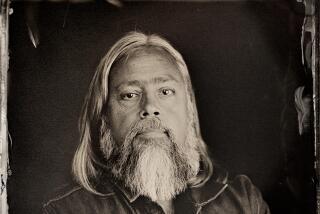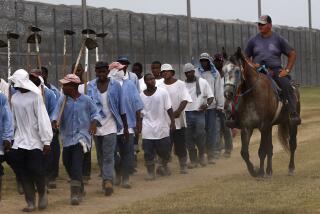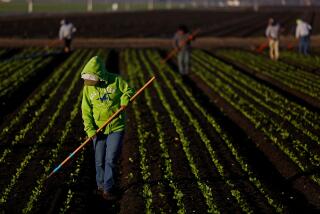Apartheid With a Human Face : NONFICTION : THE SEED IS MINE: The Life of Kas Maine; A South African Sharecropper, 1894-1985.<i> By Charles Van Onselen (Hill and Wang: $35; 649 pp.)</i>
The season-by-season story of the black sharecropper Kas Maine treks along with the seeming repetitious monotony of his native High Veld. It is 91 years of harvest and blight, rains, drought, dust storms, locusts, periodic concessions from his Boer landlords and subsequent confiscations and evictions.
Readers who make the trek, though, will discover something that, for all the accounts of jailings, deportations, pass laws and deprivations, few of us outside South Africa ever quite grasped: apartheid with a human face. It was a face ultimately more terrible for being human. Man, as the saying goes, is a wolf to man.
Readers will also discover the patriarchal face of Maine: a big man, powerful almost to the end of his days, and unquenchable right up to the end. He was a Job unable to despair, a Mother Courage who pulled a far heavier wagon through worse adversity. Four wives, 13 children and 33 grandchildren rode in it and helped push it by turns.
“The Seed Is Mine” tells of life and farming on the dry far reaches of the southwestern Transvaal, a bleak triangle bordering the Kalahari Desert and shunned by settlers until the last half of the 19th century. It tells of the black Africans who sharecropped for hardscrabble white farmers--and sometimes did better.
It describes the permanent insecurity of these Africans--only in a few areas could they own land themselves--under laws that made black sharecropping theoretically illegal. It portrays the fascinatingly complex relationships, from cruel injustice to something close to a human bond, that developed between blacks and whites, each of whom needed the other if they were to survive or even, as Maine did, modestly prosper. It was a painful symbiosis and essentially unstable.
Thus, the account ends with the forced displacement and exiling of the sharecroppers in the 1950s, when a fanatically rigid form of apartheid replaced the harsh but semi-paternalistic variety. Also, not coincidentally, when mechanization made obsolete the sharecroppers’ contribution, the intensely motivated and often highly skilled labor of their large families and the brute power of their draught animals.
“The Seed Is Mine” is political and social history, anthropology and agricultural economics, and much more. Across it moves the figure of Kas Maine, the remarkable man whose life illuminates it all. Charles van Onselen, the author, is a scholar who heads the Institute of Social Research at the University of Witwatersrand, historically South Africa’s most progressive educational institution. The book is a work of immense research, some of which--including virtually all of the many taped interviews with Maine and his descendants--was done by Van Onselen’s black collaborators.
No doubt Van Onselen, who is white, would not have elicited the astonishingly detailed and intimate account that Maine provided to his interviewers over the last six years of his life. These years were a grim ending for a man who once farmed with widely recognized skill and success. Forced out of the Transvaal, living meanly in a native resettlement “homeland,” and with most of his family dead or scattered, he was the lucid seigneur of a memory that retained everything that had ever happened to him, and of a spirit avid to ponder and reflect on it all.
Van Onselen has used the tapes, his own interviews--mainly with whites whose paths Maine crossed--and a lyrical devotion to his subject to weave together the traveler and the times and place he traveled through.
Maine was the third generation of a family from Basutoland that settled and worked in the southwestern Transvaal highlands. Originally paid for their labor with a heifer or donkey, by 1900, when Maine was growing up, the Maines had achieved the beginnings of the sharecropping arrangement that the young man would develop into something approaching prosperity. In 1946, for instance, he owned 50 head of cattle and oxen, six horses, 14 donkeys, 150 sheep and a variety of farm equipment, including a big three-shear plow and a number of wagons.
There were terrible years too, successive seasons of drought and locusts and an occasional tornado or flood. In these years, and in the winter, Maine earned money from an extraordinary variety of skills: as a stonemason, saddle-maker, cobbler, tailor, carpenter, mechanic and eventually as a celebrated folk healer. The terrible years were not just a matter of weather, though, nor of plummeting farm prices.
Between 1920 and 1967, when he was finally forced to leave the Transvaal, Maine had been a tenant-sharecropper to 19 different farmers. Some welcomed his prodigious energies and skills, allowing him a large acreage and grazing rights; others cramped him, fined him and demanded undue amounts of labor outside the sharecropping acres. Even the best landlords, who would advance him credit and give him a ewe each time one of his wives gave birth, ended the relationship in bitterness.
This was the terrible paradox. The more productive Maine became--he was known as the best and most hard-working farmer in the region--the greater the landlord’s share. Yet this very success awakened the Afrikaner darkness: How could a black farmer do so well, often better than some of the white farmers?
Furthermore, though Maine performed the required obeisance, he was a formidable man who stood up for all the rights the law still gave him. Abused too hard, he would quit or the landlord would evict him, and another, eager for his fabled skills, would take him on. But each year the political climate got worse. With dwindling herds and equipment, Maine was gradually squeezed to poorer and poorer areas.
Maine’s battle with time and place is the major part of the chronicle. His portrait, unforgettable in its flaws as well as its strengths, draws also from the story of his family. He imposed a harsh order and control upon his wives and children. From his point of view, the big family was the equivalent of what land was for the white man. It was a capital asset because of the work it could perform. Life was war and Maine’s discipline was military. One by one the wives sickened and died and the children, most of them, moved away.
It was the twilight of an era and of a prodigious figure. Van Onselen’s own encounters with Maine, and the epic voice on the tapes, have moved him beyond the customary level tones of a scholar. The unchangeability of the changing seasons, the ups and downs, the erupting and subsiding climaxes with weather, family and landlords: Over so many years and pages they take on a soporific quality. But Van Onselen rouses us, sometimes awkwardly, with extravagant phrases. Of a sandstorm, to take one of many examples: “Old Man Kalahari suddenly sat up and spat out a blob of coarse red spittle.”
It does not quite work as prose. But it works as testimony of something else: the author’s passion. The book is a long trek for us; our guide wears a zany ribbon or two to divert us and inspire himself. We grow fond of those ribbons because, despite saddle-sores, we end up immensely grateful for the journey. Van Onselen has earned his prefatory quote from Tacitus: “A historian’s foremost duty is to ensure that merit is recorded, and to confront evil deeds and words with the fear of posterity’s denunciations.”
More to Read
Sign up for our Book Club newsletter
Get the latest news, events and more from the Los Angeles Times Book Club, and help us get L.A. reading and talking.
You may occasionally receive promotional content from the Los Angeles Times.






